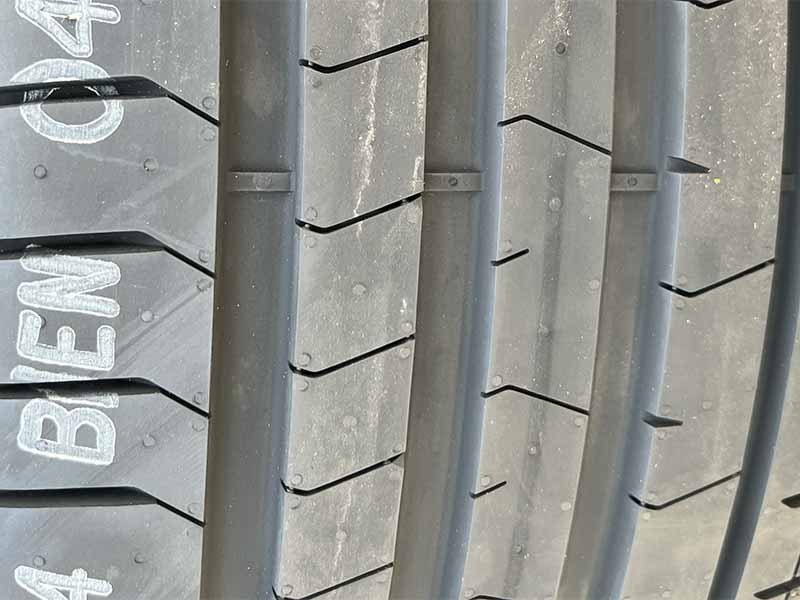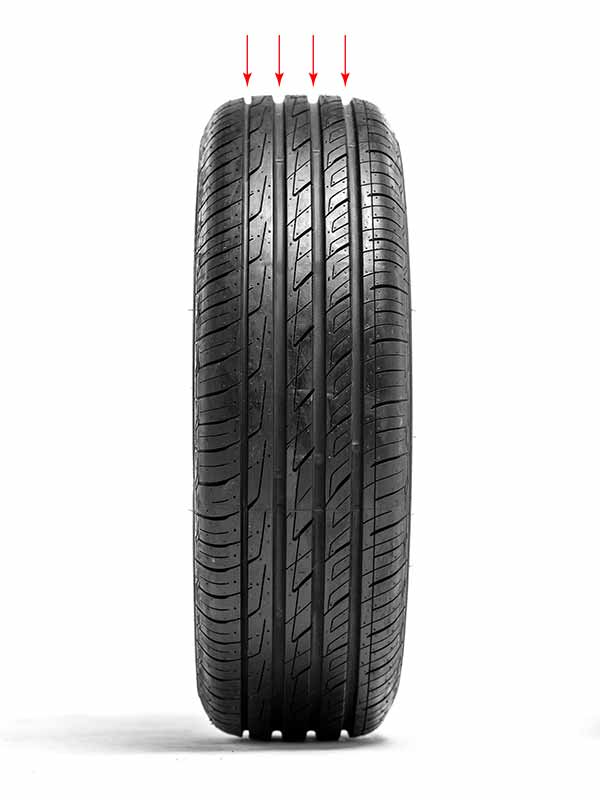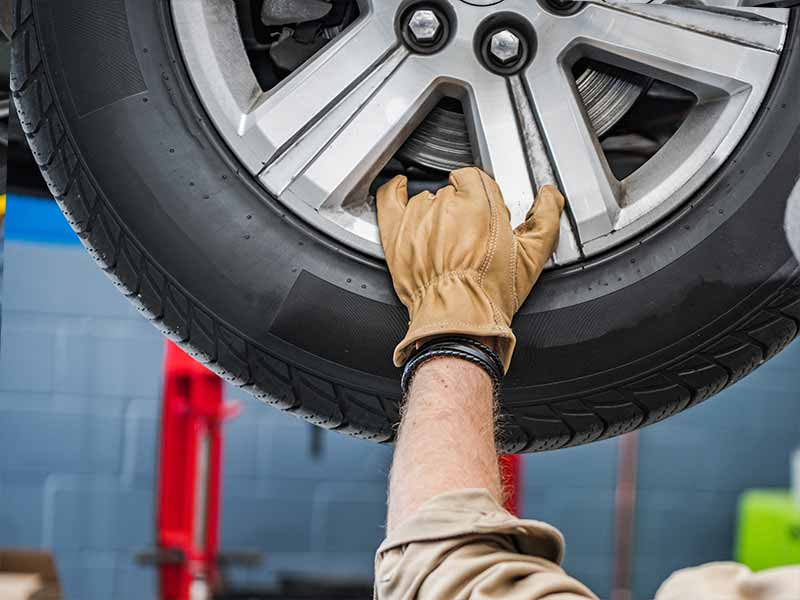Maintaining traction on wet road surfaces requires a reasonable amount of tire tread. Hydroplaning can occur even with new tires, but worn tires make it much more likely to occur at speeds as low as 35 mph or even lower.
Your tire’s tread depth is critical to the safety of your vehicle on wet roads. The grooves in your tire tread are what allow water to escape from underneath the contact patch of your tires.
How To Check Tire Tread
There are several methods for checking tire tread. The most accurate method is using tread depth gauges.
A more convenient method to test whether your tires need to be replaced is to use the penny test or quarter test.
Also, a visual inspection of the wear bars can give you a good reference point for determining how worn your tires have become.
As you can see, there are a few different methods and tools you can use to check tire tread depth. While I specifically recommend a dial-style tread depth gauge, most people will find this to be a bit overkill.
Let’s take a closer look.
How To Measure Tread Depth with A Tread Depth Gauge
A tread depth gauge is a useful tool to find out exactly how much tread you have left. It’s a specialized tool that’s designed to be used on tires.
Using a tread depth gauge is pretty straightforward. You’ll want to start with your tires installed on your car. Take the gauge and push in the measurement pin until it’s flush with the base of the gauge. This will “zero” the tool and get the pin out of the way. Doing so will ensure you get an accurate tread depth measurement.
Put the base of the tread depth gauge on top of two tread blocks. You’ll want to line up the tool so that the measurement pin goes into a tread groove. Measuring any other part of the tire will give an inaccurate measurement.
Start pushing down on the indicator gauge which is where you’ll find a list of measurements. Pushing down will push down the measurement pin.
With this gauge, you’re simply seeing how far the measurement pin was pushed down. It’s important that the pin is in contact with the bottom of the tread channel, meaning that the measurement pin is spanning the full height of the tread that you’re measuring.
Once this is done, carefully remove the tool without grabbing the indicator gauge or hitting the measurement pin at all. You want the pin to remain at the same protruded length in order to read how high the tread is.
Holding the tool, read the indicator gauge and see which number is visible. Different gauges will use different measurement increments, but you’ll want to see what the nearest 1/32” measurement is.
This is how thick your tread is in this area. You may repeat the test a few times to get an average height that’s more accurate. In addition, you should repeat this test on all four tires, and you can check different parts of each tire to get a complete picture of the tire wear around your tires.
How To Measure Tread Depth with A Penny
A penny will tell you if your tread is approaching a dangerous thickness. To perform the penny tire test, start by holding a penny so that the face of the coin is facing you. Flip it so that Lincoln’s head is still facing you, but the top of his head is at the bottom of the coin. You should be looking at an upside-down Lincoln.
Holding the penny this way, insert the penny so that Lincoln’s head goes into the groove of your tire. Push the penny as far down as it goes, then inspect how much of Lincoln you can see.
The distance from the edge of the coin to the top of Lincoln’s head is about 2/32”, which is the minimum tread depth you can safely have on your tires.
What does that mean? If you can see the whole of Lincoln’s head, it’s time to replace your tires. If the tire tread depth is between his forehead and the top of his head, then your tires are ready to be replaced but it isn’t an urgent issue.
How To Measure Tread Depth with A Quarter
You can also perform the exact same test with a quarter. Hold it in the same way — so that Washington’s face is facing you and he’s upside-down. Insert the quarter into the tire’s tread groove and see how much is exposed.
From the bottom of a quarter to Washington’s head is actually 4/32”. This amount of wear is when most experts suggest that you should change your tires before they become too bald and dangerous.
How To Read Wear Bars
Checking tire tread measurements doesn’t absolutely require placing something in the tread groove to check tire tread depth. Most new tires come with a feature built into the design of the tread pattern called a wear bar.
Wear bars are small raised bumps located at several points around the circumference of your tires in the main tread grooves. These wear bars are 2/32″ in height which equals the legal minimum depth in most states.
While you can’t get an exact measurement from your wear bars, you can get a good idea of how closely your tires are coming to reaching the minimum depth or whether they have already reached that point by a simple visual inspection.

Where To Measure Tire Tread Depth
You’ll notice a common theme with most tires. Non-directional tires have strips of tread around the circumference followed by shallow, recessed strips. These recessed strips are called the tread channels or grooves, and it’s the lowest point of your tire’s circumference.
Directional tires may not have deep grooves that run around the entire circumference of the tire tread, but they will still have deep grooves as well as some smaller grooves to help improve grip.
When you want to know how thick your tire treads are, you want to know the total distance from the bottom of the main deep tread grooves to the top of your tread blocks (the tread surface).
If you could cut your tire in half, it’d be easy to use a tape measure to see how tall your tread is. The problem is that the tread is small, and the groove is even smaller. It’s tough to fit an instrument in there to get an accurate measurement.
This is why experts suggest using a specialized tire tread gauge, a penny, or a quarter.

Minimum Tread Depth
The minimum tread depth is when your tires are so low that they’re dangerous to use. This is when laws will force you to change your tires, and it’s well past the point when experts will suggest you replace your tires.
Legally, the minimum tread depth is going to vary from state to state:
- In 42 states, 2/32 is the legal minimum tread depth
- In 2 states, 1/32 is the legal minimum tread depth
- In 6 states, there is no legal minimum tread depth
When your treads get down to 2/32, your stopping distance increases by 100% when panic braking on wet roads. That’s twice the distance it takes brand-new tires to come to a complete stop, given the same starting conditions.
What Is an Unsafe Tire Tread Depth?
Most tire experts suggest that you should change your tires well before the legally required minimum tread depth. We recommend you purchase new tires when your current tires have reached 4/32” of the tire’s tread depth remaining.
It’s always better to replace your tires sooner rather than later. Every time you lose 1/32” of tread, your car becomes slightly less capable of channeling water out from underneath the contact patch of your tires. Once you get down to below 4/32”, you run a much higher risk of being unable to come to a stop quickly enough or hydroplaning and getting into a serious accident.
Think about it: if you’re approaching a stopped car, every foot between you and them matters. If your tires require double the amount of space, you have a much higher risk of hitting them.
In reality, there’s nothing stopping you from changing your tires with 5/32” left of tire tread. The only downside is that you’ll be wasting time and money by replacing them so prematurely. Instead, you can wait a little longer before the replacement is more necessary and optimizes the relationship between safety and money spent.
Tread Depth to Replace Tires
2/32″ is the point at which you must replace tires in most states. However, tire experts recommend you replace your tires is when the tread is worn down to between 4/32” and 3/32”.
Waiting any longer will make your vehicle too unsafe to drive in moderate to heavy rain conditions. Doing it any sooner will be premature, and will cause you to spend more money than you need to on tires (since you’ll be replacing them more often than you need).
The difference in wet weather performance between 4/32″ and 2/32″ is drastic. The amount of performance lost between new tires and those worn all the way down to 4/32″ is significant. But the additional 2/32″ of wear doubles that performance loss for a very small amount of additional mileage.
Resources
Below are some links you may find helpful when learning about tires
Final Thoughts
For a few dollars, a dial tread depth gauge is a handy tool, very accurate, and extremely easy to read and use.
The penny test and quarter test are great to check tire tread depth when the tread wear is close to replacement.
Wear bars eliminate the need to use a measuring device but offer even less precision and are really meant to let you know when you’ve reached the minimum amount of tread remaining.
Good luck and happy motoring.







